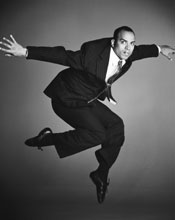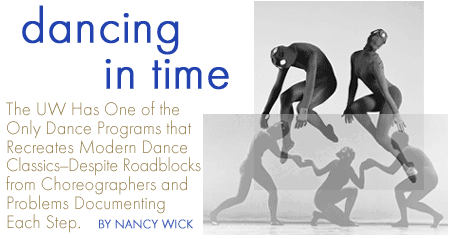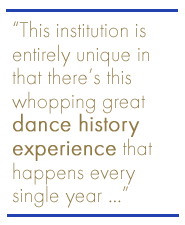
Chamber Dance Company member Hector Vegas recreates Daniel Nagrin's 1948 solo Strange Hero. Photo by Joel Levin

Wiley taught herself to read it, but says she is hardly an expert. She has, on occasion, obtained scores to reconstruct a dance. More often, however, she has to go directly to choreographers or their heirs to obtain a dance, with widely varying results.
Sometimes a choreographer will immediately say yes and cite a reasonable price. Bill Evans, for example, only charged $450 for a 15-minute dance called For Betty. Betsy Fisher, who staged four dances by Mary Wigmann, a contemporary of Kurt Jooss, charged only $1,275.
Then there are dances like The Green Table. It's expensive because the owner requires that two choreographers be in residence for five weeks and a third person for one week to "set the dance" on the CDC, and the UW must pay their expenses.
And money isn't the only problem she faces in reconstructing dances. Choreographer Daniel Nagrin, for example, required that Wiley and the performers sign a contract promising not to talk to anyone about his dances. Some choreographers are simply reluctant to permit Wiley to have their dances at all. She asked Susan Marshall every year for eight years if she could stage a dance called Kiss before Marshall finally agreed. Lar Lubovitch said no to a CDC performance of North Star for at least as long before relenting when a dancer he knew joined the company.

Choreographers often refuse permission to do their dances out of fear "that their work will be out there and be done badly," Susan Maguire says. Maguire ought to know something about it, since she is the director of the Paul Taylor School, Taylor2, and supervises reconstructions of Paul Taylor dances. She recently set his 3 Epitaphs on the CDC.
"I have mixed feelings about the situation," she says. "I think yes if it's going to be done before the public, then it has to be the best possible performance of that piece given the circumstances. But I wish there were a way for repertory to be made accessible to dancers who are in training for a very modest fee. I mean, how many times have we heard Beethoven played badly but it doesn't matter. It doesn't hurt Beethoven's reputation."
The UW has an advantage in convincing choreographers to grant permission to do their dances, however. The CDC is made up of professional dancers because the MFA program in dance is designed for professional dancers who are coming back to the academy after a performing career. Most are pursuing the degree in order to transition into education or some other post-performance endeavor, and the Chamber Dance Company puts their professional experience to good use.
 Restaging the classics, Wiley says now, was in part a recruiting tool. "I thought that if we were going to create a grad program that would attract mature professional dancers, we had to somehow make it clear to them that their performances would be of master works," she explained. "I didn't want to ask them to come here and be in a Hannah Wiley dance."
Restaging the classics, Wiley says now, was in part a recruiting tool. "I thought that if we were going to create a grad program that would attract mature professional dancers, we had to somehow make it clear to them that their performances would be of master works," she explained. "I didn't want to ask them to come here and be in a Hannah Wiley dance."
Once here, Wiley thought, the dancers would be able to give undergraduate dance students -indeed, anyone who came to the concerts - the gift of seeing historically significant dances. What she didn't anticipate is how much the graduate students received from the experience.
"Many of these folks who come to the degree program may have danced with one or two major companies, so the work they have in their bodies is the work from that company," she says. "It actually is transformative in some cases, where people have been locked into a certain vision through the eyes of their mentor, and the historical dances have served as a key to move them beyond it."
Current Dance Director Cooper, who earned her MFA at the UW, came here certain that she wanted to pursue dance history as her teaching specialty—an interest that grew out of a childhood in New York City, where she had had the opportunity to see work by many of the major choreographers. Cooper was excited by the prospect of working with professional dancers like herself and deepening her knowledge of dance.
So when, after teaching elsewhere, Cooper applied for the UW director position, she proposed that a new course be created—called "The Creative Context." The course, which she now teaches, uses the works being performed in the CDC's yearly concert as the basis for an in-depth investigation of the socio-political, economic and aesthetic context in which the works were created. Students read and write about the choreographers, they attend a rehearsal and a performance of the concert and they have a conversation with the dancers.
The class introduces a whole new group of students to dance history in a very direct way. Although undergraduate dance majors have always been welcome at CDC rehearsals, most of the Creative Context students are not dancers, Cooper says.
Go To: Page 1 | Page 2 | Page 3